1 Lets return to our video gaming franchise from our previou
1. Let’s return to our video gaming franchise from our previous problem set. Now,
however, we’ll examine how the presence of either monopoly or monopsony
powers (for the franchise OR for the gamers!) affects the behavior of both the
market for matches (output) and the market for gamers (labor input). Onward.
A sports franchise has the following production function for output in terms of
its only factor input:
Q = F ( L ) = 2L Q: matches / week
L: gamers /week
The demand curve for this product is given by:
QD = 100 – P P: $ / match
Q: matches / week
Assume, also, that instead of being perfectly inelastic, the supply curve of
gamers (the labor input) is given by:
LS = ½ W – 10 W: $ / gamer
L: gamers / week
a. Initially, suppose the franchise has NEITHER monopoly power in the output
market NOR monopsony power in the input market. Basically, there are too
many substitutes for watching video game matches for this franchise to have
power over the price they can charge for broadcasting rights AND there are too
many substitutes jobs for gamers that the franchise has no power over wages
either. Thus, they are output and input price takers.
i. The franchise’s production function exhibits ___________ returns to
scale, and its MRPL , initially, is equal to:
a. Constant ; P
b. Increasing ; 2P
c. Constant ; 2P
d. Increasing ; P
ii. If the franchise maximizes profit, it will hire gamers up to the point
where:
a. W = P
b. W = 2P
c. W / P = 1
d. W = 2
iii. Equilibrium in both the labor (gamer) market and the output (matches)
market for this profit maximizing firm implies:
a. 2L + 20 = 200 – 4L
b. Q + 20 = 200 – 2Q
c. Both (a) and (b) are true.
d. Neither (a) nor (b) is true.
iv. With no power over price in either its output or input markets, then, this
franchise will maximize profit by producing __________ matches.
a. 30
b. 40
c. 50
d. 60
v. The franchise thus maximizes profit by hiring _______ gamers (labor) at
a wage of ______ / gamer.
a. 15 ; $50
b. 20 ; $60
c. 25 ; $70
d. 30 ; $80
vi. The franchise collects a price of _________ per match for broadcast
rights and realizes a profit of ___________.
a. $70 ; $900
b. $60 ; $800
c. $50 ; $800
d. $40 ; $0
b. Suppose, INSTEAD, that this franchise is a monopsonist but NOT a monopolist.
How might this be? Well, they may have monopsony power in the labor
(gamer) market, because video game skills are so very specific that they do not
lend themselves to other labor market opportunities. However, broadcasters still
have innumerable substitutes for what they air, so the franchise still sells its
product in a perfectly competitive output (match) market.
As a result of the franchise’s monopsony power in its labor market, it must
increase wages if it wishes to hire more gamers because it faces the entire labor
supply curve rather than taking the market wage as given. Therefore, its MEL
schedule, in units of $ / gamer (often also referred to as its Marginal Factor
Cost schedule) will be given by:
MEL = D TC / DL = 4L + 20
vii. In order to maximize profit, the franchise will now hire labor up to the
point where:
a. 4L + 20 = W
b. 4L + 20 = 2
c. 4L + 20 = 2P
d. 2L + 20 = 2P
viii. With this monopsony power in the labor (gamer) market but NO
monopoly power in the output (match) market, this franchise maximizes
profit by airing ___________ matches.
a. 30
b. 40
c. 45
d. 50
ix. In this case, the franchise thus maximizes profit by hiring _______
gamers (labor) at a wage of _____ / gamer.
a. 15 ; 50
b. 20 ; 60
c. 22.5 ; 65
d. 25 ; 70
x. In this case, the franchise collects a price of _______ per match for
broadcast rights and realizes a profit of ___________.
a. $70 ; $1250
b. $60 ; $2250
c. $55 ; $1012.50
d. $50 ; $2250
c. Finally, let’s assume that franchise has BOTH monopoly power in the output
(match) market AND monopsony power in its labor (gamer) market. We must
now find a new MR schedule ( in units of $ / match ) for the franchise, as it
now has power over the price it charges for broadcast rights to matches:
MR = D TR / DQ = 100 – 2Q
xi. With both monopoly & monopsony power, this franchise will hire labor
(gamers) up to the point where:
a. 4L + 20 = 100 – 4L
b. 4L + 20 = 200 – 8L
c. 4L + 20 = 100 – 2L
d. W = 2L
xii. If the franchise thus has BOTH monopoly power in the output (match)
market and monopsony power in the input (gamer) market, it will
maximize profit by producing ________ matches.
a. 15
b. 20
c. 25
d. 30
xiii. In this case, the franchise thus maximizes profit by hiring ______ gamers
at a wage of ______ / gamer.
a. 15 ; $15
b. 50 ; $15
c. 15 ; $50
d. 50 ; $50
xiv. In this case, the franchise charges a price of _________ per match for
broadcast rights and realizes a profit of ___________.
a. $30 ; $900
b. $50 ; $1250
c. $15 ; $1350
d. $70 ; $1350
xv. In this case, which of the following represents the franchise’s total cost
(TC) function? [Hints: TC for this franchise will just be W*L , but
remember that it sets wages according to the LS curve! In this case,
when you consider the total cost for this producer, the wage is no longer
a given variable. It will be determined by the LS curve – thus, the
monopsony power. The firm must increase its wage to hire another unit
of labor. Then make sure to express TC is a function of ou
2. Rank order tournaments use a non-linear reward structure largely because it:
a. Lowers the overall prize money associated with the tournament.
b. Ensures amateurs as well as professionals will participate in the
tournament.
c. Attracts fewer advertisers, saving the tournament committee resources.
d. Leads to a greater average effort level among participants in the
tournament.
3. Consider the following quotes from an article explaining why QB Tom Brady
essentially never threw to wide receiver Chad Ochocinco (Chad Johnson) during
the latter’s one season with the New England Patriots:
“Johnson failed to grasp New England’s complex, read-based offense and never
developed a rhythm with Brady during his one season in Foxboro, Mass.”
“ ‘Great team,’ Johnson said. . ‘Really, really, really great team. But not the
right system for my type of style of play, or just a predominantly outside
receiver...’ “
Economists might classify Chad Johnson as having a _________ level of
general human capital and a ________ level of specific human capital as it
relates to his employment with the Patriots.
a. High ; high
b. High ; low
c. Low ; high
d. Low ; low
4. The designated hitter (DH) in Major League Baseball was established in 1973
only in the American League (they still play REAL baseball in the National
League, thankfully!).
Chronic Traumatic Encephalopathy CTE issues in the National Football League
have contributed to increased levels of both dementia and suicide among former
players.
Economists would historically attribute fights against the DH as an issue for
_________ while policies to address CTE as an issue for _____________.
a. Craft unions ; Congress
b. Industrial unions ; craft unions
c. Craft unions ; industrial unions
d. Industrial unions ; Congress
5. One might argue that a bilateral monopoly exists in many of the major
professional sports because the league has _____________ and the players’
union has _____________.
a. Monopsony power in wage setting ; monopoly power in selling players’
services.
b. Monopoly power in selling broadcasting rights ; monopsony power in
buying broadcasting rights.
c. Monopoly power in selling broadcasting rights ; monopsony power in
wage setting.
d. Monopsony power in buying broadcasting rights ; monopoly power in
selling players’ services.
6. Free agency in the NFL has caused:
a. Both average incomes and the Gini coefficient to rise.
b. Average incomes to rise but the Gini coefficient to fall.
c. Average incomes to fall but the Gini coefficient to rise.
d. Both average incomes and the Gini coefficient to fall.
7. Suppose the production function of our sports gaming franchise is given by:
q = 10 * ( LW + LNW )1/2
Where q is measured in matches, and LW and LNW represent white players
(labor) and non-white players (labor), respectively.
We can then show that, indeed, white and non-white players are perfect
substitutes in the production of matches, as evidenced by the fact that for either
type, the marginal product of labor is represented by:
MPL = 5 / ( LW + LNW )1/2
[Note: As expected, the MPL decreases in both LW and LNW .]
Suppose the market wage for non-white players is $10 / player, while the
market wage for white players is $20 / player. The value of output to the
franchise (again measured in broadcasting rights fees) is $100 / match .
a. Assume at first that the franchise does NOT discriminate and seeks to maximize
profit.
i. In this case, the franchise would hire ________ players, ________ of
whom are white.
a. 100 ; all
b. 100 ; none
c. 625 ; all
d. 2500 ; None
ii. In this case, the franchise would produce (air) _________ matches and
earn profits of ________.
a. 100 ; $10,000
b. 100 ; $0
c. 250 ; $12,500
d. 500 ; $25,000
b. Now, assume the franchise develops a taste for discrimination and has a
discrimination coefficient ( di ) of 0.25 .
iii. With this discrimination coefficient, the franchise maximizes profit by
hiring ________ players, ________ of whom are white.
a. 625 ; all
b. 1600 ; none
c. 625 ; none
d. 1600 ; all
iv. With this discrimination coefficient, the franchise would produce (air)
_________ matches and earn profits of ________.
a. 100 ; $10,000
b. 100 ; $0
c. 400 ; $24,000
d. 500 ; $25,000
c. Finally, suppose that over time, the franchise’s taste for discrimination
intensifies, raising its discrimination coefficient to 1.25 .
v. With this higher discrimination coefficient, the franchise maximizes
profit by hiring ________ players, ________ of whom are white.
a. 100 ; all
b. 100 ; half
c. 625 ; all
d. 2500 ; None
vi. With this higher discrimination coefficient, the franchise would produce
(air) _________ matches and earn profits of ________.
a. 100 ; $10,000
b. 100 ; $0
c. 250 ; $12,500
d. 500 ; $25,000
vii. This franchise suffers a profit loss from having a taste for discrimination
because the value of the marginal products of white players and nonwhite
players are in fact ________, but they act as if the costs of hiring
white players and non-white players are __________.
a. Equal ; equal
b. Equal ; unequal
c. Unequal ; equal
d. Unequal ; unequal
8. Most mainstream economists view discrimination as
a. The result of a misperception of people’s true skills.
b. A way for capitalists to keep the working class from uniting.
c. A taste.
d. Overstated in models of wage behavior.
9. Suppose an African-American athlete in a given sport makes 20% more than a
white athlete in that sport. Discrimination against the African-American ______
possible because __________.
a. Is not ; the African-American athlete’s salary is higher.
b. Is not ; the white athlete’s salary is lower.
c. Is ; the two players’ marginal revenue products might be equal.
d. Is ; the two players’ marginal revenue products might not be equal.
10. Integration was much faster in football than in baseball because
a. Of competition provided by a rival league.
b. The owners in the NFL were less discriminatory than the owners in
MLB.
c. Football fans are far less discriminatory than baseball fans.
d. Football had to get the approval of liberal-minded colleges and
universities.
11. It is often difficult to determine whether women are victims of discrimination in
professional sports because
a. Women have brought far fewer discrimination suits.
b. It is difficult to separate out racial effects from gender effects.
c. Women aren’t as good at sports as men.
d. Women seldom compete with men in the same event.
12. If the proportion of women is greater at Temple University than at Villanova,
then Title IX stipulates
a. Temple University should spend a higher percentage of its athletic
budget on women’s sports.
b. Temple University should spend a greater amount of money on women’s
sports.
c. Both schools should spend 50% of their athletic budgets on women’s
sports.
d. Nothing in this case, because Title IX is based on the number of female
athletes.
13. One problem with Title IX has been that
a. Women’s teams have underperformed men’s teams in the same sport.
b. There are now more opportunities for women than interested athletes.
c. It forces women to compete directly with men.
d. Some schools have dropped men’s sports instead of adding women’s.
14. In 2007, the Chicago Fire of Major League Soccer signed Cuauhtemoc Blanco,
one of Mexico’s most famous players. They have paid Blanco, an aging star,
the second highest salary in Major League Soccer largely to cater to Hispanic
fans in Chicago. Economists would classify this as an example of:
a. Employer discrimination
b. Employee discrimination
c. Customer discrimination
d. Any of the above
Solution
1) In the perfectly competitive market,labor is hired until its MFC=MRP
where MFC=w=2(100-2L) and MRP=PxMPL
Given w=2 and MPL=100-2L
we have,w=2(100-2L)
=100-2L=(1/2)w
2L=100-1/2w
Ld=50-1/4w option (C)
2) Given totol number of firms = 20
Therefore league\'s labor demand = 20 x 50-1/4w
= 1000-5w option (C)
3) The franchise and league demand curve slope downwards because of option (A) diminishing marginal product of gamers.
4) Labor demand = 1000-5w, Lanor supply = 200
At equilibrium D=S
Therefore,1000-5w=200
or w = 800/5 = 160 per week option (B)
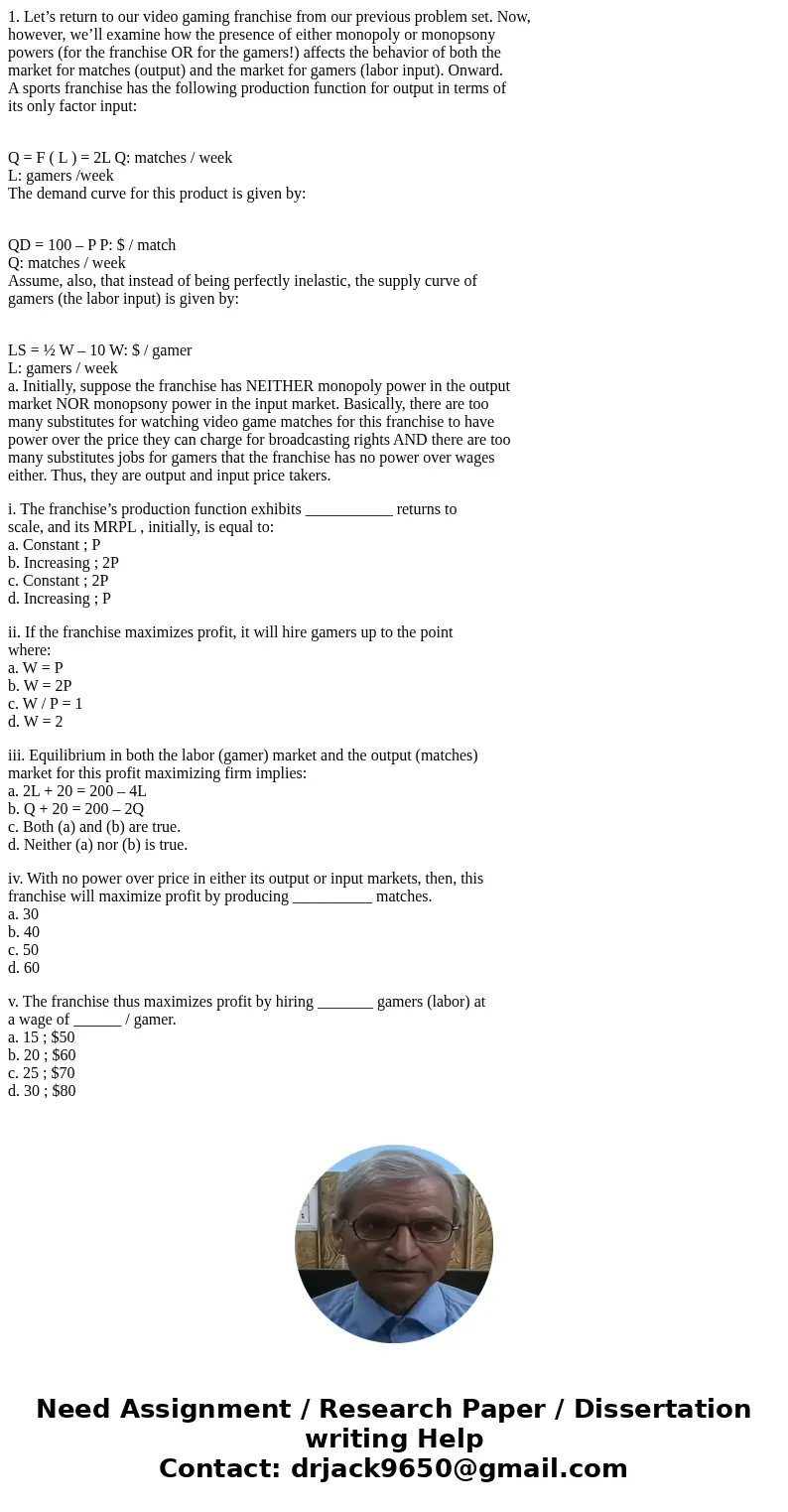
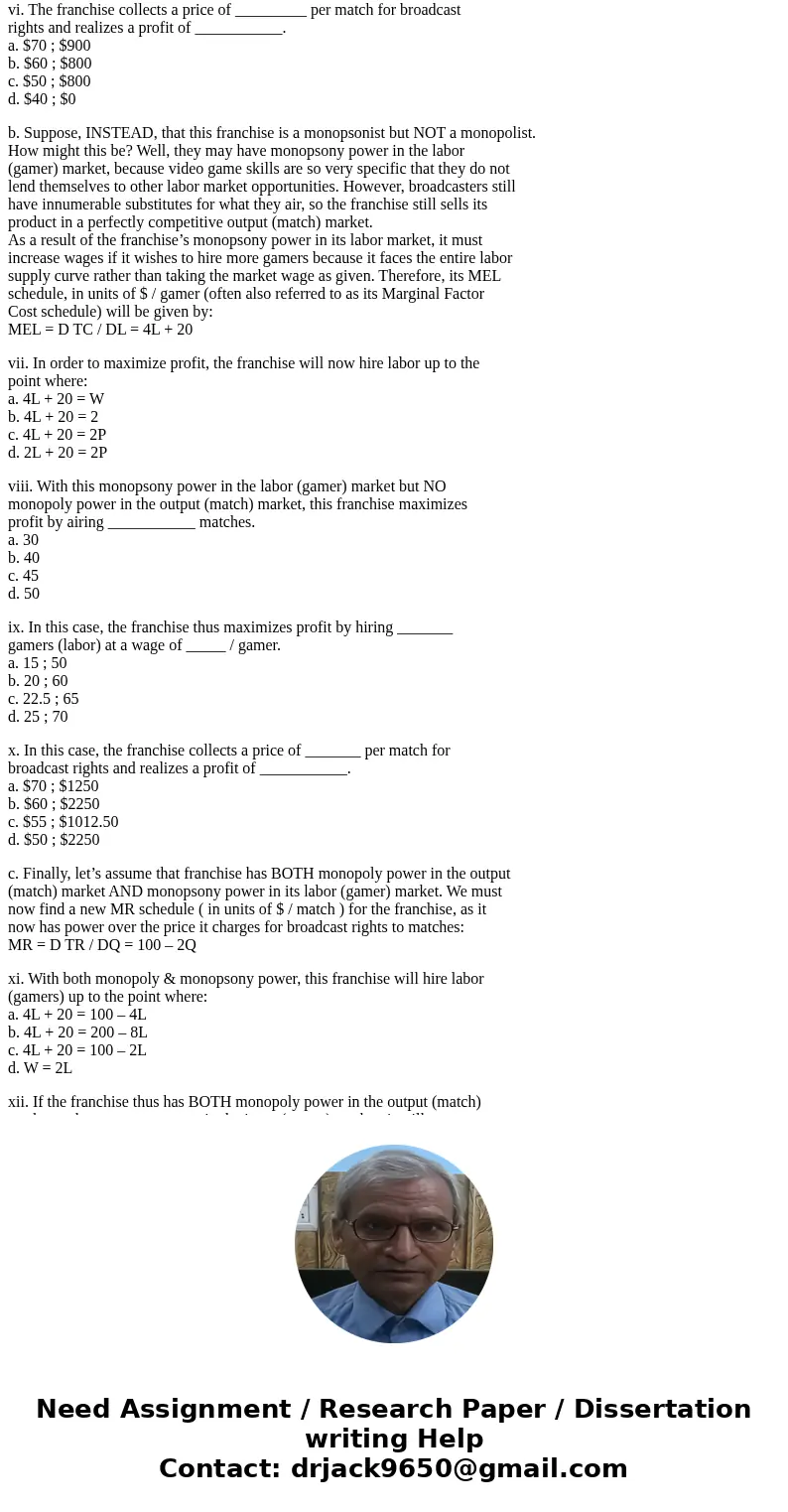
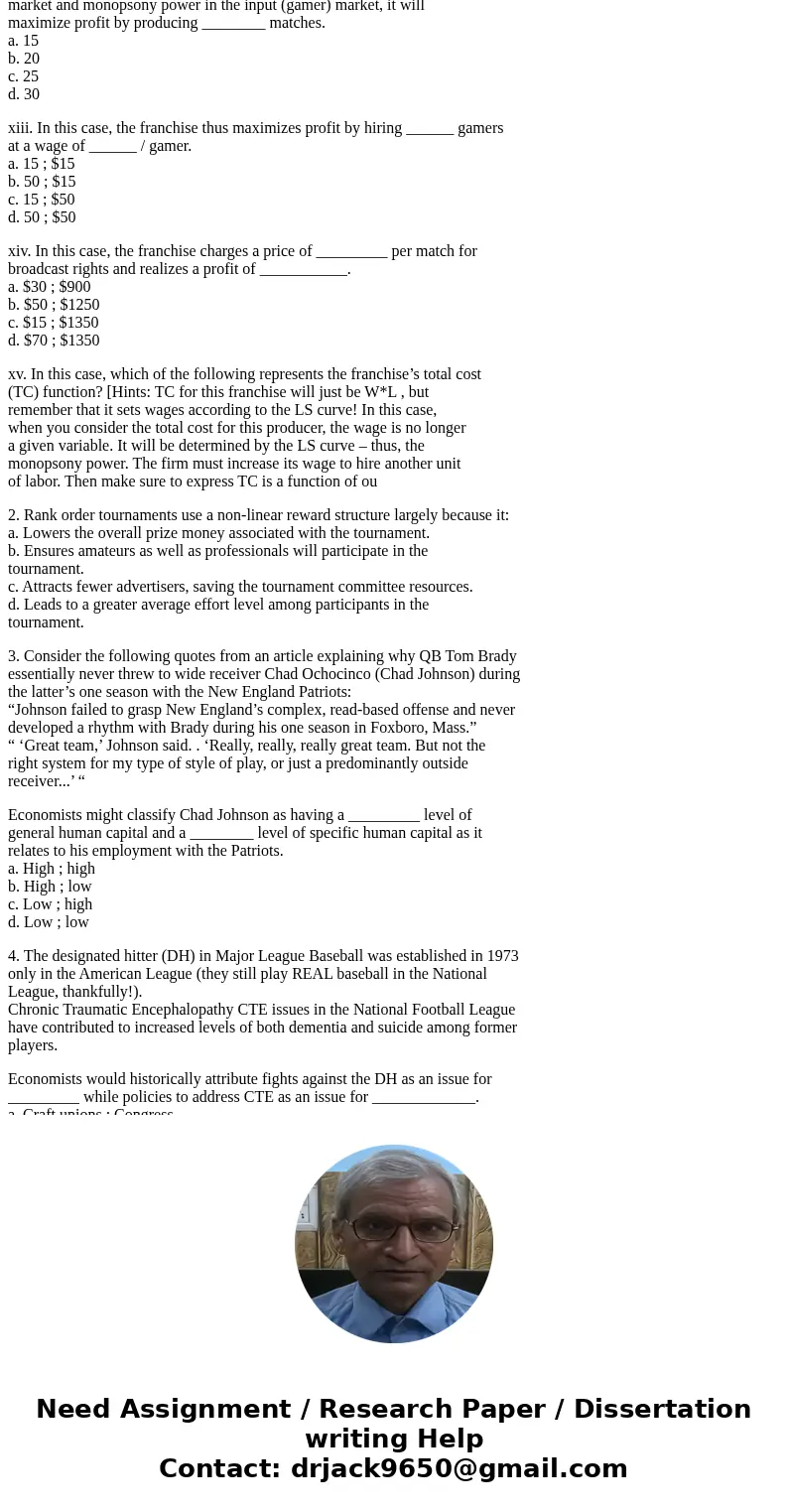
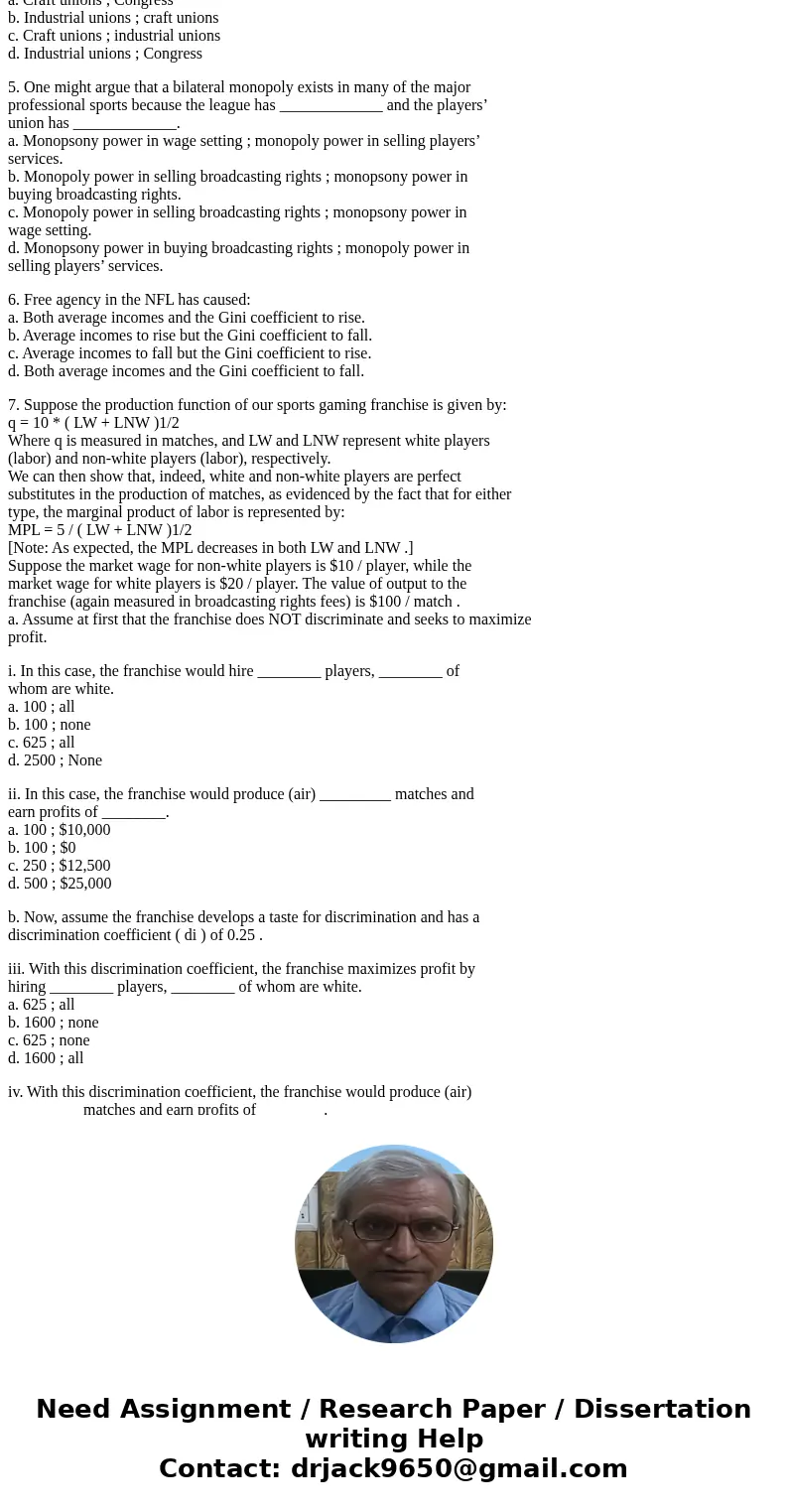
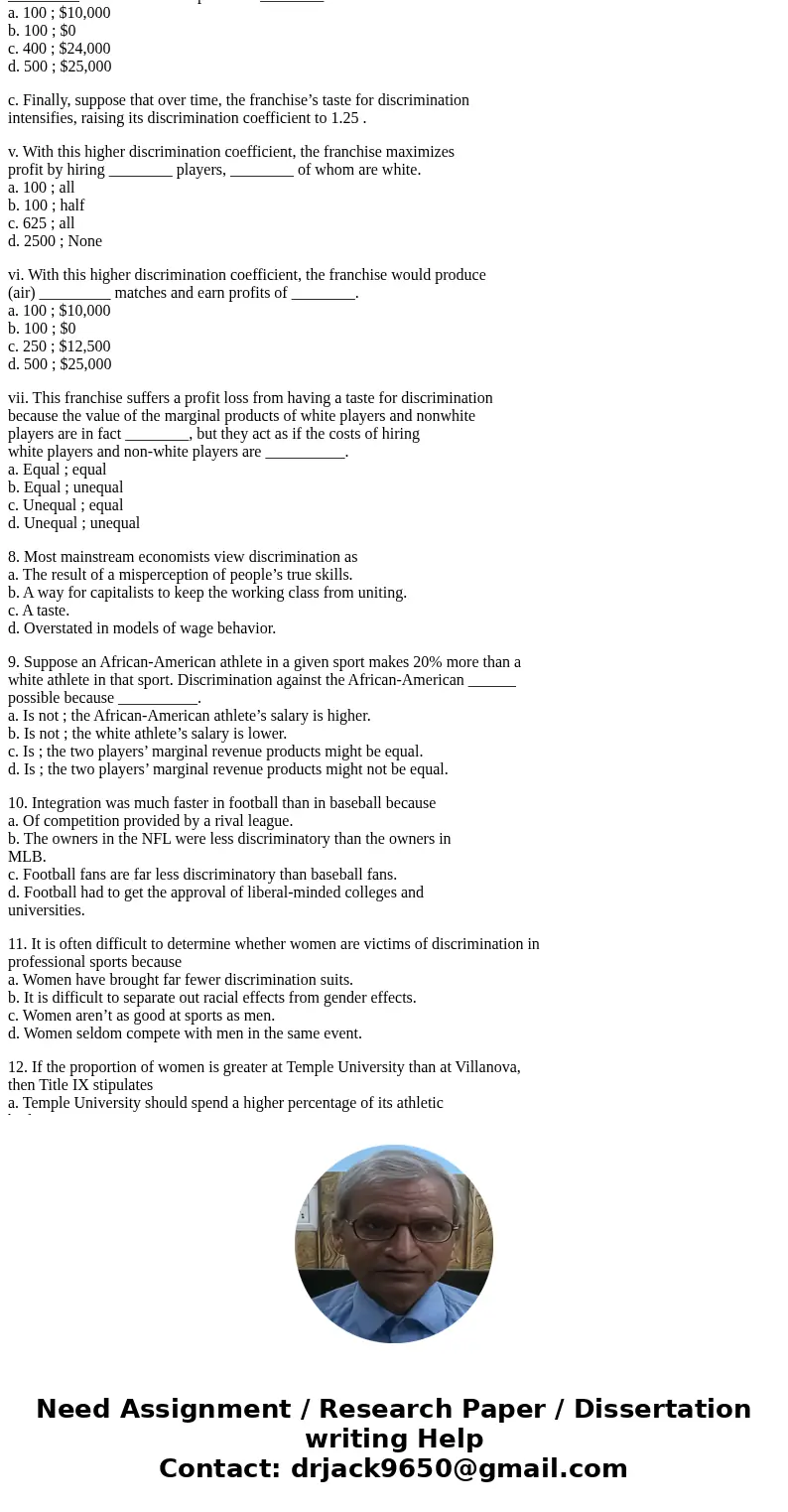
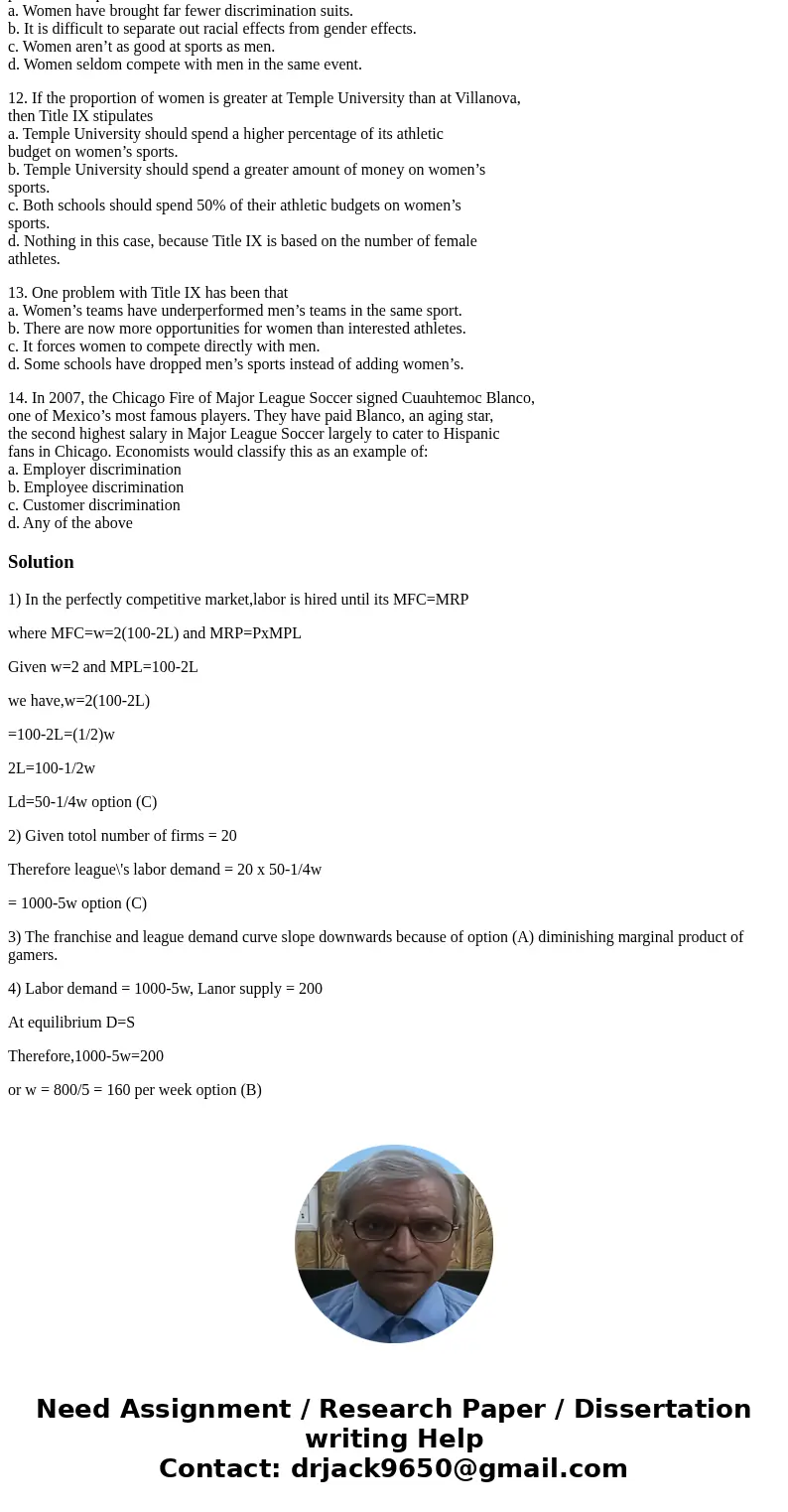
 Homework Sourse
Homework Sourse